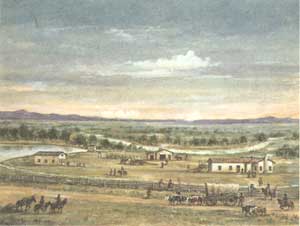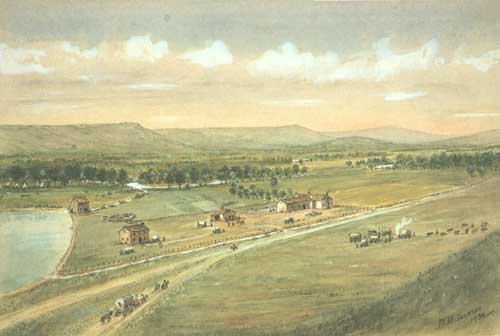
INTRODUCTION
By Marian Albright Schenk
FOREWORD
By Dean Knudsen
SECTION 1
Primary Themes of Jackson's Art
SECTION 2
Paintings of the Oregon Trail
SECTION 3
Historic Scenes From the West
 |
| During a 1937 visit William Henry Jackson is credited with catching these trout at Yellowstone Lake. While not an ardent fisherman, he did enjoy golf. According to Jackson, "If we duffers seldom broke a hundred, we always made it up at the 'nineteenth hole' afterward." (SCBL 2686) |

Section 3: Historic Scenes from the West
WHITMAN MISSION
The Whitman Mission at Waiilatpu, near present-day Walla Walla, Washington, was established in 1836 by Marcus and Narcissa Whitman. Two of the most famous missionaries on the western frontier, the Whitmans were among the earliest to make their way to Oregon. By successfully reaching Oregon, the Whitmans were the first to prove that both a wagon and a family could make the trip. By way of the letters they mailed home, the Whitmans also proved to be effective at persuading others to make the journey to Oregon.
The Whitmans were less successful in their efforts to bring the Christian faith to the Cayuse Indians. Although the Whitmans operated a hospital and school for the tribe, most of the Cayuse resisted the missionaries' attempts to convert to Christianity. Over time, resentment and frustration on both sides combined to form an uneasy atmosphere at the mission.
In first few years after being established, the mission was located directly on the primary route into Oregon and served as a popular stopover for travelers on the Oregon Trail who needed supplies, wagon repairs, or medical attention. However, after 1844, a shorter route was developed to the south which effectively bypassed the mission altogether.
 |
| This undated painting is very similar to Whitman Mission, Washington, but has a slightly different perspective. (SCBL 151) |
For the next three years, the only emigrants who visited the mission were those in desperate need, and this proved to be the Whitman's undoing. The problem came in the form of a measles epidemic which broke out on the trail in the fall of 1847. As a physician, Marcus Whitman offered the only hope for those with the disease. Unfortunately, there was little he could do and many of the emigrants died.
To make matters worse, some of the Cayuse who came down to trade dried fish and corn with the emigrants contracted the disease. Lacking any immunity to measles, the Cayuse suffered terribly and nearly half of the tribe died while Whitman was helpless to do anything. Resentful and suspicious, some of the Cayuse came to believe that Whitman was deliberately poisoning the Indians so that the new emigrants could take over their land.
On November 29, 1847, there was a violent outbreak, and Marcus and Narcissa Whitman and eleven other people were killed by the vengeful Cayuse. Forty seven people, many of them children, were taken captive and held for several weeks until a ransom was paid.1 Despite the violence, emigration to Oregon continued unabated. In 1848 Oregon was established as an American territory, and statehood was achieved in 1859.
It is not known if Jackson visited the Whitman Mission prior to attending the site's centennial in August of 1936,2 or if he simply based his paintings on historic drawings or narratives. However, the Whitmans were important pioneers on the Oregon Trail, and their deaths at the hands of the people they had come to save is a tragic chapter in the history of the Oregon Trail.
1. David Lavender, Westward Vision, The Story of the Oregon Trail, (New York City: Bison Books, 1985), 398-399.
2. Jackson, Time Exposure, 336.
 |
| Whitman Mission. Signed and dated 1940. 23.5 x 36.9 cm. (SCBL 45) |
 |
scbl/knudsen/sec3f.htm Last Updated: 14-Apr-2006 |
 |